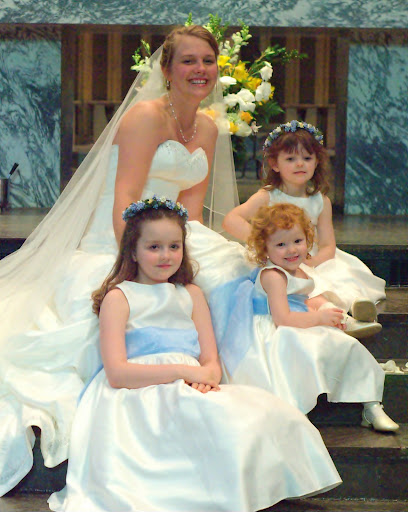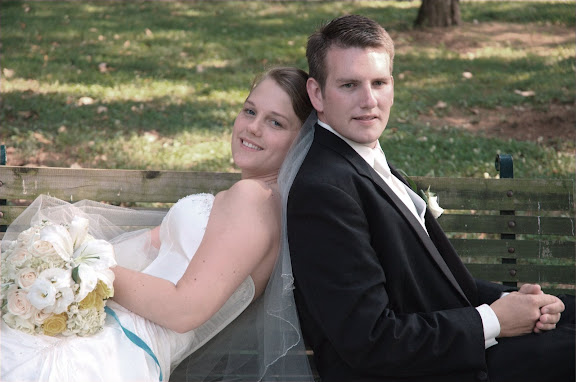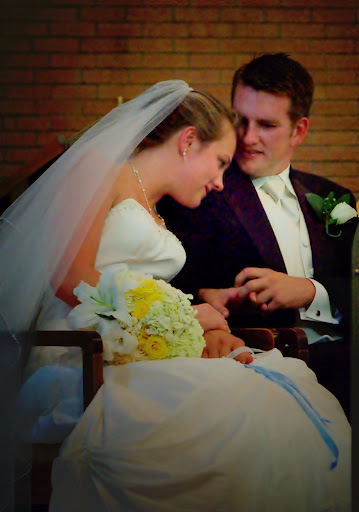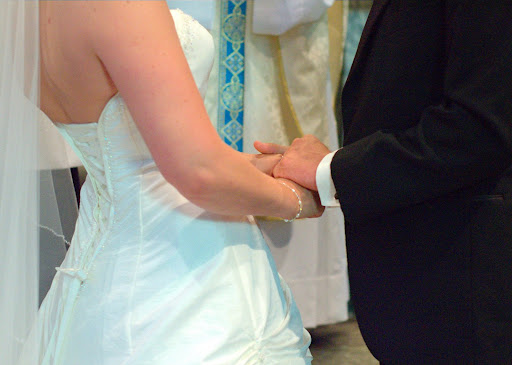I was about to go on another search for strange facts when suddenly I had the idea of posting how some old wedding traditions got started! I hope you enjoy this as much as I did! I know it's very long, but I simply love learning about traditions and how they got started.... :)
The engagement ring – one of the oldest of the Western European wedding traditions.
One of the ancient traditions of Western Europe which is still going strong today is the idea of the engagement ring. It was way back in 860 A.D. that Pope Nicholas I proclaimed that not only was an engagement ring required to seal the agreement to be married, but that the engagement ring must be made of gold. The making of the ring out of gold signified that the groom was willing to make a financial sacrifice for his new bride-to-be.
It would be another 617 years before the tradition of adding a diamond to an engagement ring would be started. It was in the year 1477 that King Maximilian presented the lovely Mary of Burgundy with a diamond engagement ring, and from that day to this a diamond has been a girl’s best friend.
It was in Italy, the land of love, that gold wedding rings first became popular, and it was also in Italy that the tradition of the wedding cake was first begun when, in the first century B.C., a cake or bread was broken over the bride’s head to insure fertility.
The tradition of the Best Man began in medieval Germany.
It was in ancient Germany that the Western European tradition of a Best Man began. In olden days it was sometimes necessary for a man to kidnap his bride from a neighboring village and he needed his strongest friend (his Best Man) to help with the kidnapping and to stand by him at the wedding ceremony to fight off any relatives that might try to take her back. (Yikes!)
Something old, something new, something borrowed, something blue.
But it was in England that many of our most enduring Western European wedding traditions got their beginning. The ancient nursery rhyme about something old, something new, something borrowed, something blue is now an important part of most Western European weddings, even though many brides and grooms no longer know the significance of the rhyme.
Something old is symbolic of continuity. The old item was often a piece of lace or a grandmother’s scarf or an old piece of jewelry. Something new signifies hope for the future, and can be anything from a piece of clothing to the wedding band itself. Something borrowed is symbolic of future happiness and is often provided by a happily married friend of the bride. And finally, something blue. In ancient times blue was the color of purity and often both the bride and the groom wore a band of blue cloth around the bottom of their wedding attire.
Before the German Wedding Day
According to German wedding tradition, when a baby girl is born in Germany, several trees are planted in honor of her birth. When her wedding date is set, the trees are sold, and the money is used for her dowry.
A unique German pre-wedding custom is the creation of a wedding newspaper by the friends and family of the bride and groom. This newspaper, or booklet, is filled with pictures, articles and stories of the engaged couple. The newspaper is sold at the wedding reception, to assist with the expenses of the honeymoon.
Belgium wedding Traditions
One of the most important and enduring traditions of the Belgium wedding is for the bride to carry a specially embroidered handkerchief that has her name embroidered on it. After the wedding this handkerchief is framed and hung on the wall in a place of honor. When the next female member of the bride’s family is to be wed, the handkerchief is removed from its frame, the new bride’s name is embroidered onto it, and it is passed down.
The wedding handkerchief is passed from generation to generation, and is considered an important family heirloom.
During the wedding mass the bride and the groom are enthroned in two large chairs placed near the alter, symbolizing that on this day and in this place they are the king and the queen. At the conclusion of the ceremony the groom slips the wedding ring onto the third finger of his bride’s left hand. The ring, being an endless circle, symbolizes never-ending love, and the third finger of the left hand is believed to hold the vein that travels to the heart, symbolizing love.
Austrian Wedding Customs and Traditions
Choosing the day
Although most weddings take place on a Saturday it was considered unlucky in the past. Fridays were also considered unlucky particularly Friday the 13th. The famous old rhyme advises a wedding in the first half of the week:
“Monday for wealth, Tuesday for health, Wednesday the best day of all, Thursday for losses, Friday for crosses, Saturday for no luck at all.”
Wedding Decorations and Traditions in Spain
Orange blossoms have long been the flower of choice for a girl getting married in Spain. Since the orange tree bears fruit and blossoms at the same time it's flowers represent happiness and fulfillment.
Before a couple getting married in Spain exchange their vows in church, the groom gives his bride a wedding present of thirteen coins. This gift is a symbol of his commitment to support her. The bride-to-be then carries these coins, in a little bag, to her wedding ceremony.
Eastern European Wedding Traditions
May you be blessed with long life, prosperity, happiness and fertility
Many Eastern European wedding traditions concern long life, fertility and happiness and prosperity. In Czechoslovakia, for example, the bride’s friends would often plant a tree in her yard and decorate it with ribbons and brightly-painted egg shells. The belief was that the bride would live as long as the tree. Traditionally an infant would be laid on the couple’s wedding bed as a symbol of fertility. After the ceremony the young couple would traditionally break plates and the more pieces the plates broke into the more successful their marriage would be.
In Hungary a new bride wore an elaborate headdress at her wedding in which was woven strands of wheat as a symbol of fertility. Also a new bride would be presented with an egg. By smashing it she would insure the health of her future children. Traditionally the new bride would present her husband with a gift of seven scarves, seven being a lucky number and signifying her desire for a long and happy marriage.
A wedding tradition in Poland holds that the parents of the couple present them with rye bread sprinkled with salt and a glass of wine. The bread symbolizes hope that the couple will never go hungry, the salt symbolizes that life will have its difficulties, and the wine is a blessing for health and happiness.








